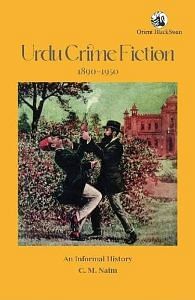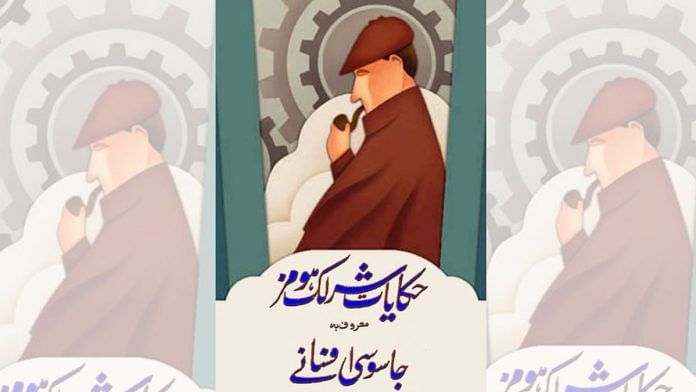A few Urdu speakers in India must have read Doyle’s tales even as they were appearing in Strand since the magazine was easily available in India; a great many more Indians, we can be sure, read them in the two collections, The Adventures of Sherlock Holmes and The Memoirs of Sherlock Holmes, as they came out in 1892 and 1894 respectively. It took a few more years, however, for someone to introduce him to Urdu readers. The earliest translation, so far found, dates to 1903. It is a translation of ‘The Red Headed League,’ titled ‘Ajīb Sāzish (A Strange Conspiracy), and published as an independent book of 34 pages.
The translator, Muhammad Muhsin Faruqi, is described on the cover as a hakīm—a practitioner of the Greco-Arabic system of medicine—born in a small qasba in Moradabad district. In his brief introduction, Faruqi tells us that (1) the book was a fruit of his efforts in the very first year of his learning English, and that (2) it was his second book, since the first book, a similar ‘fruit,’ was lengthier and still in the press. A marginal note indicates that the first book came out before March 1903, and that the second translation was titled Khāmosh Surāghrasāñ (The Silent Detective). Very likely it was another Holmes story, though the Urdu title does not immediately suggest any in the Holmesian canon. (‘The Adventure of the Dying Detective’ came out in 1913.) Faruqi’s translation is fairly accurate, but often too literal. As a result, his language is too formal compared to the original, and not so enjoyable—it could not have pleased the new generation of readers who relished the more colloquial narration by then popular in all periodicals and newspapers. The relatively high cost of the small book could not have attracted many buyers either.
Later the same year, the weekly Intikhāb-e Lājavāb (The Matchless Selections), published from Lahore, began to serialise a translation of A Study in Scarlet under the title Joshīlā Qātil (The Passionate Murderer) that continued into 1904. The translator was Syed Mustafa Athar. Intikhāb-e Lājavāb (Lahore), edited and published by Munshi Mahbub Alam, was a weekly modeled on the famous English weekly Tit-Bits.
Alam was an extraordinary entrepreneur, who made his fortune through innovative journalism and publishing. His most famous venture was the Paisa Akhbār (The Penny Newspaper), which was modeled on the ‘Penny’ journals of England. The journal lasted for many years, first as a weekly and later as a daily, and at its peak, it claimed to have a circulation of several thousand, reaching far beyond the Punjab. Alam was also the first to publish a monthly magazine exclusively for women, Sharīf Bībiyāñ (Genteel Ladies), and another monthly exclusively for children, Bacchoñ kā Akhbār (The Children’s Journal). Besides being a successful publisher and journalist, he was also a prolific writer himself, specially of instructional books on different technologies and trades that were then beginning to appear in India. His press published much popular fiction, including anonymous translations of crime fiction done by its staff as was noted in Chapter 1.
There is no record that Joshīlā Qātil was ever published as a separate book. Nor have I come across any other publication by Syed Mustafa Athar. The translation, however, was briefly re- serialised in 1913, with a new title: Sachchā Intiqām yā Bahādur Raqīb (The True Revenge, or The Brave Rival), but discontinued after a few instalments when several subscribers complained that they had read it ten years earlier. The over-conscientious publisher paid no heed to the appeals of the new subscribers who were left in the dark.
A Study in Scarlet was retranslated and published as an independent book in 1920. The new translator, Firozuddin Murad, was a professor of Physics at the Aligarh Muslim University. He called his translation Khūñnāba-e ‘Ishq (Blood-tears of Passion); however, when he republished it in 1930 he changed the title to a plainly descriptive, Sharlak Homz kā Pahlā Kārnāma (The First Adventure of Sherlock Holmes). Evidently, by that time the name of the detective was all that mattered to attract attention to a book. Murad was such an ardent admirer of Doyle and his ‘ratiocinating’ human machine that he contacted Doyle and asked for his permission to translate him into Urdu—a rare instance in Urdu literary history. And Doyle generously gave it too—for all his Holmes stories! It was a sad choice on Doyle’s part, for Murad’s translation is earnest but clunky, and he tends to abridge too often as he goes along.
Another equally earnest attempt was a third translation of A Study in Scarlet called Tishna-e Khūn (The Bloodthirsty). The translator was Lala Amarnath ‘Mohsin’ of Amritsar. The cover describes it as ‘a novel that won laurels in the field of detection (jāsūsi) with the help of Physiognomy, Anatomy and Chemistry.’ It is, however, an abridged translation, and, most curiously has the appearance of a play script—it is chiefly in the form of verbal exchanges between the characters of the story, and all other portions of the original narrative have been severely shortened or entirely omitted. This peculiar feature of Mohsin’s enterprise could reflect the fascination many Urdu writers of the early years of the twentieth century had for ‘naturalistic’ dialogue as opposed to the ‘idiomatic’ exchanges of Nazir Ahmad and Sarshar that were cherished earlier. As noted in our discussion of Reynolds’s novels, any prowess with dialogues was considered a matter of pride by many Urdu fiction writers of those early years. Mohsin’s translation, however, was not a plagiarism of Murad’s book. In fact, his language has some nice literary flourishes of the old-fashioned kind, whereas Murad’s only relatively fuller translation is ever so often clumsily literal.
The following year, Murad published a second book, Hikāyāt-e Sharlak Homz (The Fables of Sherlock Holmes), containing twelve tales from Doyle’s four collections. Included were: ‘A Scandal in Bohemia,’ ‘The Man with the Twisted Lip,’ ‘The Adventure of the Blue Carbuncle,’ ‘The Adventure of the Beryl Coronet,’ ‘The Adventure of the Speckled Band,’ ‘The Adventure of the Naval Treaty,’ ‘The Final Problem,’ ‘The Adventure of the Empty House,’ ‘The Adventure of the Three Students,’ ‘The Adventure of the Second Stain,’ ‘The Adventure of the Norwood Builder,’ and ‘The Adventure of the Dying Detective.’
Murad calls these stories dilchasp (interesting) and sabaq- āmoz (instructive), and explains in a preface why he liked them so much. ‘These stories,’ he writes, ‘excel in teaching how to use one’s eyes properly, draw correct conclusions [from what is observed], and then build a scientifically convincing argument. I have read these stories several times over the past twenty years, and I believe they will be most beneficial (mufīd) in Urdu.’
 This excerpt from ‘Urdu Crime Fiction 1890–1950: An Informal History’, authored by CM Naim, has been published with permission from Orient Blackswan.
This excerpt from ‘Urdu Crime Fiction 1890–1950: An Informal History’, authored by CM Naim, has been published with permission from Orient Blackswan.



